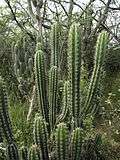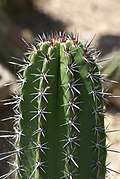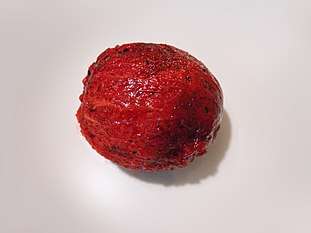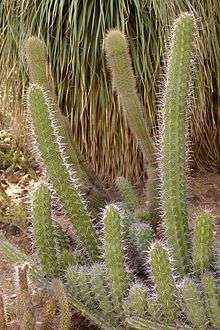Stenocereus
Stenocereus (Gk. stenos, narrow, L. cereus, candle) is a genus of columnar or tree-like cacti from the Baja California Peninsula and other parts of Mexico, Arizona in the United States, Colombia, Costa Rica, Guatemala, Venezuela and the ABC islands of the Dutch Caribbean. The genus has been enlarged by the addition of species from several other genera. A close relative is the peculiar chinoa or chende cactus, Polaskia chende.
| Stenocereus | |
|---|---|
| Organ Pipe Cactus Stenocereus thurberi | |
| Scientific classification | |
| Kingdom: | |
| (unranked): | |
| (unranked): | |
| (unranked): | Core eudicots |
| Order: | |
| Family: | |
| Subfamily: | |
| Tribe: | |
| Genus: | Stenocereus |
| Species | |
|
Several, see text | |
| Synonyms | |
The flowers are mostly borne near the apex of the stems and mostly nocturnal. They are considered easy to grow and generally grow slowly.
Stenocereus thurberi (the organ pipe cactus) is a well-known member of this genus and is widely distributed in Arizona and northern Mexico.
The fruit is similar to a dragon fruit. Those of Stenocereus gummosus, acidic and very refreshing, are highly favored by the Seris of northwestern Mexico[1] who call the cactus ziix is ccapxl[2] - "thing whose fruit is sour". It is commonly known in Spanish as pitaya agria, or by the English translation Sour Pitaya. S. griseus (Dagger Cactus) fruits, locally known as iguaraya, are relished by the Wayuu from the La Guajira Peninsula of Colombia.[3]
Stenocereus are often used as ornamental plants in hot and arid regions, and as noted above, some species can double as a fruit crop.
The interior of Stenocereus trunks often grows to form tough, cane-like stakes suitable for certain kinds of construction. The Wayuu use those of Dagger Cactus for building wattle and daub walls, a technique they call yotojoro, after their name for the cactus wood "canes".[3]
Selected species
| Image | Scientific name | Common Name | Distribution |
|---|---|---|---|
| Stenocereus alamosensis (J.M. Coult.) A.C. Gibson & K.E. Horak | Octopus cactus, cina | Mexico | |
 | Stenocereus aragonii (F.A.C.Weber) Buxb. | Costa Rica | |
 | Stenocereus beneckei (Ehrenb.) A. Berger & Buxb. | Central Mexico | |
| Stenocereus chacalapensis (Bravo & T. MacDoug.) Buxb. | Oaxaca - Mexico | ||
| Stenocereus chrysocarpus Sánchez-Mej. | Guerrero and Michoacán, Mexico | ||
 | Stenocereus eichlamii (Britton & Rose) Buxb. ex Bravo | Guanocal, Organo, Pitahaya, Tuna | Guatemala : Chiapas - Mexico (Central America, North America) |
| Stenocereus eruca (Brandegee) A.C. Gibson & K.E. Horak | Creeping devil caterpillar cactus | Baja California Sur - Mexico | |
 | Stenocereus fimbriatus (Lam.) Lourteig | Cuba, Hispaniola (Haiti, Dominican Republic) : Jamaica, Puerto Rico - Greater Antilles (West Indies - Caribbean) | |
| Stenocereus fricii Sánchez-Mej. | Pitayo De Aguas | Colima, Jalisco, Michoacan de Ocampo - Mexico | |
.jpg) | Stenocereus griseus (Haw.) Buxb. | Dagger cactus, yosú (Wayuunaiki) | Mexico to Venezuela |
| Stenocereus gummosus (Engelm.) A. Gibson & K.E. Horak | Sour pitaya, pitaya agria, ziix is ccapxl (Cmiique iitom) | Baja California (Norte), Baja California Sur - Mexico | |
| Stenocereus kerberi K. Schum.) A.C. Gibson & K.E. Horak | Colima, Sinaloa - Mexico | ||
| Stenocereus martinezii (J.G. Ortega) Buxb. | Pitahayo, Pitayo | Sinaloa - Mexico | |
 | Stenocereus montanus (Britton & Rose) Buxb. | Chihuahua, Colima, Jalisco, Nayarit, Sinaloa, Sonora - Mexico | |
.jpg) | Stenocereus pruinosus (Otto ex Pfeiff.) Buxb. | Chiapas, Guerrero, Oaxaca, Puebla, Tamaulipas, Veracruz-Llave - Mexico | |
| Stenocereus queretaroensis F.A.C.Weber ex Mathes.) Buxb. | Colima, Guanajuato, Jalisco, Michoacan de Ocampo, Queretaro de Zaragoza - Mexico | ||
| Stenocereus quevedonis (J.G. Ortega) Buxb. | Pitire | Sinaloa - Mexico | |
| Stenocereus standleyi (J.G. Ortega) Buxb. | Pitaya Marismena | Guerrero, Sinaloa - Mexico | |
 | Stenocereus stellatus (Pfeiff.) Riccob. | Baja organ pipe cactus | Oaxaca, Morelos, Puebla - Mexico |
.jpg) | Stenocereus thurberi (Engelm.) Buxb. | Organpipe cactus | Baja California (Norte), Baja California Sur, Sinaloa, Sonora - Mexico, Arizona - United States |
.jpg) | Stenocereus treleasei (Vaupel) Backeb. | Tunillo | Oaxaca - Mexico |
| Stenocereus yunckeri (Standl.) P.V. Heath | Guatemala, Honduras | ||
 Close-up of organpipe cactus (S. thurberi) spines
Close-up of organpipe cactus (S. thurberi) spines Fruit of Stenocereus queretaroensis prepared for eating
Fruit of Stenocereus queretaroensis prepared for eating
Footnotes
- Felger & Moser (1985)
- Kozak, David L. (2013). Inside Dazzling Mountains: Southwest Native Verbal Arts Native literatures of the Americas UPCC book collections on Project MUSE. U of Nebraska Press. pp. 48–49. ISBN 9780803240865.
- Villalobos et al. (2007)
References
- Anderson, Edward F. (2001): The Cactus Family
- Felger, Richard & Moser, Mary B. (1985): People of the desert and sea: ethnobotany of the Seri Indians. University of Arizona Press, Tucson
- Innes, C. & Wall, B. (1995): Cacti, Succulents and Bromaliads. Cassell & The Royal Horticultural Society.
- Villalobos, Soraya; Vargas, Orlando & Melo, Sandra (2007): Uso, manejo y conservacion de "yosú", Stenocereus griseus (Cactaceae) en la Alta Guajira colombiana [Usage, Management and Conservation of yosú, Stenocereus griseus (Cactaceae), in the Upper Guajira, Colombia]. [Spanish with English abstract] Acta Biologica Colombiana 12(1): 99-112. PDF fulltext
External links
| Wikimedia Commons has media related to Stenocereus. |

- cactiguide.com